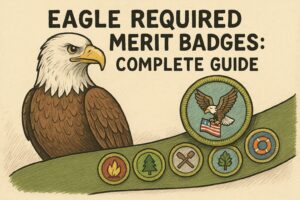How to Support Your Scout—Without Doing the Work for Them
The journey to Eagle Scout is a significant milestone—not just for Scouts, but for the parents who cheer them on from the sidelines. It requires persistence, leadership, and years of dedication. Although the rank is earned by the Scout alone, the support of a parent often makes the difference between giving up and pushing through.
That said, there’s a fine line between helpful support and over-involvement. Parents play a critical role, but Scouts need the freedom to lead and make their own decisions. This guide explains how you can help your Scout succeed—without stepping in too far.
Why Parental Support Matters
Scouts BSA is designed to build youth-led leadership. While that independence helps young people grow, it also means they may stumble or struggle without encouragement.
In fact, most Eagle Scouts have a support system—especially at home. Parents who offer logistical help, emotional encouragement, and occasional reminders often empower their Scouts to stay focused and on track. However, true success comes when Scouts complete the journey themselves.
What Is the Eagle Scout Rank?
The Eagle Scout rank is the highest achievement in the Scouts BSA program. It demands much more than just time—it requires leadership, service, and discipline.
To earn Eagle, Scouts must:
- Complete 21 merit badges, including 14 required ones
- Serve in troop leadership roles
- Plan and carry out a major Eagle Scout service project
- Complete a Scoutmaster conference and a final board of review
It’s important to note that all of this must be completed before the Scout’s 18th birthday. While some Scouts begin the final stretch early, many tackle the final steps between ages 14 and 17.
What Parents Can—and Should—Do
Supporting your Scout doesn’t mean doing the work for them. Instead, it means providing the structure, encouragement, and resources they need to succeed. Here’s how you can help effectively:
1. Coordinate Logistics (Without Taking Over)
Many Scouts struggle with time management and transportation. You can help by:
- Driving them to meetings, merit badge sessions, or service projects
- Helping them look ahead at troop calendars or merit badge clinics
- Offering to manage shared calendars or reminders—if they ask for help
Be sure your Scout is still taking initiative. Let them be the one to schedule appointments or communicate with leaders.
2. Encourage Time Management
Since most Scouts juggle multiple commitments, time can easily slip away. Help your Scout by:
- Suggesting a timeline after they reach Life rank
- Breaking down big tasks (like the Eagle project) into manageable goals
- Asking about their progress every few weeks—not every day
These check-ins should feel supportive, not like pressure.
3. Keep Them Accountable in a Healthy Way
Rather than giving orders, ask thoughtful questions:
- “What’s your next step for that merit badge?”
- “Have you looked into who might approve your project?”
By shifting the focus to their decisions, you help them build confidence in leading their own advancement.
4. Be a Sounding Board—Not a Fixer
Mistakes are part of the process. For example, your Scout might forget a deadline or submit an incomplete draft. These moments are growth opportunities.
Instead of jumping in to fix the problem, guide them through it:
- “What do you think needs to change?”
- “Who can you talk to in your troop to help resolve it?”
This teaches problem-solving and responsibility—two key outcomes of the Eagle journey.
5. Support the Eagle Project Thoughtfully
The Eagle project is where Scouts often ask for the most help—and that’s okay. However, they must remain the project leader.
Parents can:
- Offer ideas or suggest community contacts
- Help with transportation, tools, or safety supervision
- Review their proposal drafts, but only after they’ve written them
Let your Scout handle approvals, scheduling, and volunteer coordination. Your role is backup—not boss.
What to Avoid
Even with the best intentions, it’s possible to overstep. Be careful not to:
- Contact leaders or merit badge counselors on your Scout’s behalf
- Fill out advancement paperwork for them
- Speak for them during Scoutmaster conferences or reviews
- Pressure them to finish if they’re not ready
Let your Scout take ownership of their journey.
How to Stay Involved Without Taking Control
It’s natural to want updates—but there’s a right way to stay informed:
- Use shared checklists or digital trackers together
- Ask your Scout to explain their plan at milestones
- Attend troop events and Boards of Review as a supportive presence
If you’re unsure how much involvement is appropriate, don’t hesitate to ask your Scoutmaster. They’ll help guide you on how best to support your Scout at each stage.
Final Thoughts
The Eagle Scout journey is meant to be challenging—and rewarding. When your Scout reaches Eagle, they’ll know they earned it entirely through their own effort. That pride is something no one can give them—but your support helps make it possible.
As a parent, your job is to guide without leading, cheer without pushing, and encourage without rescuing. With that balance, you’ll empower your Scout to rise to the challenge and reach the highest rank in Scouting.





